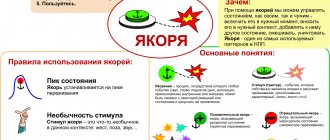We are used to thinking that hypnosis is the work of scammers and charlatans or just part of the show. Hypnosis is often compared to psychic abilities. In fact, it's not like that.
Surprisingly, hypnotists do not have supernatural powers. They simply use the necessary knowledge and skills, thanks to which they help people relax and immerse themselves in a state of trance.
You can try hypnosis on yourself.
And in this article, I will tell you that self-hypnosis is a technique that will help you fulfill your desires and find the happy life you dream of.
What are you dreaming about?
About a new car, increasing income, living in a happy marriage, going on a trip, meeting new friends? You have the right to want whatever you want.
Moreover, you can get everything you dream of. And this can be done with the help of self-hypnosis.
I myself have been using self-hypnosis for a long time to fulfill desires: one lesson in my master class on wish fulfillment is devoted to this technique.
As a rule, I give students a script, after reading which they very easily immerse themselves in self-hypnosis with their eyes open. I learned this technique from an American psychotherapist.
In this article you will read another, classic technique of self-hypnosis.
What is self-hypnosis and why is it needed?
Self-hypnosis is the skill of independently and controlled entry into a trance, hypnotic state, without the participation of another person.
Self-hypnosis is close to meditation, auto-training, prayer, it can be called visualization, self-hypnosis, controlled imagination, etc. The point is that having learned to enter this special state and make suggestions in it that are pre-selected for the individual situation, a person uses the capabilities of his body and psyche to achieve goals.
Self-hypnosis: technique of wish fulfillment
Using self-hypnosis, you are immersed in a trance.
In a trance state, new commands and affirmations are remembered and perceived as one’s own much easier. A person changes and changes his life at his own discretion. By regularly practicing self-hypnosis, you can achieve success in completely different areas of life:
- get a certain thing;
- meet the right person;
- increase income;
- be happy in a relationship;
- achieve ideal health;
- achieve concrete changes in life.
On topic: How to fulfill several desires at once?
Self-hypnosis techniques
Where to begin? First of all, you need to learn how to enter a trance state. Further, in this state, you will be able to make deep self-hypnosis for yourself, including post-hypnotic ones, i.e. those that will work outside of trance, when you need it.
How to enter a trance? In general, any person is already familiar with the trance state - for example, when you “withdraw into yourself”, into your thoughts, you can lose your sense of reality for some time. While thinking about something important or being carried away by reading, you may not notice how much time has passed and may not hear the words addressed to you. Such states differ from self-hypnosis only in that the latter involves targeted, motivated influence with the formulation of suggestions that correspond to specific goals.
Contrary to popular myth, in a state of hypnosis and self-hypnosis you not only do not lose control over yourself, but also strengthen it. And if you need to respond to an external situation, you can, even while in a trance, react quite adequately.
Self-hypnosis: what is the benefit of it?
Self-hypnosis is a technique that is absolutely safe for health and is effective for self-influence and mental self-regulation.
Immersion in your own inner world makes it possible to know yourself and fulfill any desire. After all, no one knows a person better than himself, and by nature, this knowledge is deeply hidden from us.
Self-hypnosis is the conscious, controlled ability of a person to immerse himself in a hypnotic state, as well as the ability to realize various phenomena characteristic of a hypnotic state. The technique of self-hypnosis must include a component called self-hypnosis.
Self-hypnosis is the introduction into the brain of figuratively imagined commands or attitudes against the background of a hypnotic state of consciousness. Read more about self-hypnosis in my article Self-hypnosis: how to do it correctly so that it works? As self-hypnosis, we can also use affirmations, which I wrote about in my articles:
Affirmations for love? Why not! What money affirmations really change reality?
Self-hypnosis is a whole mechanism that helps you independently manage physiological and mental processes, and do it consciously and for your own benefit.
By practicing self-hypnosis and self-hypnosis, a person receives a unique opportunity to program his own reality, fulfill desires, heal the body, and attract the right people and things.
This can only be done correctly by working with the subconscious, which is why the ability to put oneself into a trance state is desirable and useful.
Being in the moment between wakefulness and sleep, a person is freed from the factors that constrain him, the controlling function of consciousness is turned off, which will make it possible to focus on his desire and turn it into life.
So, what are the self-hypnosis techniques?
Conventionally, self-hypnosis tools can be divided into two large groups:
- techniques for entering a trance: fixation of attention and relaxation
- self-hypnosis techniques
There are many ways to enter a trance state. Let's look at the basic, simplest ones.
First of all, take the most comfortable position
It's best to sit rather than lie down unless you plan to fall asleep. Place your feet on the floor, lean your back on the back of a chair or armchair, or sit relaxed, leaning forward slightly, find a comfortable position in which you can be in a relaxed state for some time.
One of the easiest ways to enter a hypnotic state is through breathing. In ordinary life, most people's breathing is shallow and rapid. For the purpose of deep relaxation and immersion in a trance, it is useful to learn diaphragmatic breathing.
Inhale deeply and slowly through your nose and exhale even more slowly through your mouth. After breathing like this for some time, you will feel how the relaxation reaction has started: your heart rate slows down, blood flows to your limbs, and your muscles relax.
Next exercise: inhale for four counts.
hold your breath for the same amount and exhale twice as slow, again hold your breath for four counts. Perform several such cycles in a row. You can set your own breathing rhythm, the main thing is that the exhalation is longer than the inhalation. The purpose of this exercise is to achieve calm and relaxation.
Deep breathing in itself is an excellent signal for relaxation and can be used for this purpose outside of trance. You just need to set yourself during the session that when the need arises to relieve stress, you need to take a few deep breaths and exhalations so that a feeling of complete peace appears.
Another way to enter a trance state is to fixate your attention on some object.
for example, on a point on the wall, on a burning candle, etc., on a sound (for example, on the sound of your heart beating or on some monotonous sound) or on your own breathing. Choose any method
Focus all your attention on the selected object for 5-10 minutes, focus on it as much as possible. You can notice all extraneous thoughts and return all your attention to the object. After some time, you may feel relaxed in your body and want to close your eyes. Transfer all your attention inside yourself and stay in this state for some time. Feeling slightly numb and relaxed, you will enter a shallow hypnotic state.
After practicing entering a hypnotic state, you can begin self-hypnosis. State the goal you want to achieve. It's best to set one specific goal for each activity. To begin with, set important but simple tasks, for example, learn to relax, quickly rest and recuperate, improve sleep, make waking up more pleasant, etc.
Write down your goals. Having determined what you want to achieve, create a self-hypnosis formula. Here you need to follow several important rules:
- The wording should be positive and affirmative. Eliminate words and particles such as “not”, “no”, “without”, “get rid of”, “throw away”. Replace them with positive wording, for example, instead of “don’t be late” - “come on time, be on time”, instead of “don’t get sick” - “be healthy”, etc. If you suffer from insomnia, the suggestion may sound like “deep, sound sleep “I fall asleep easily and quickly”
If you are tormented by insomnia and want to get rid of it, then read the article: “how to get rid of insomnia”
- Use your imagination: while speaking suggestions, imagine the image of your target in detail and vividly. A figurative representation can greatly enhance the effect of suggestion, since the image itself is a suggestion. You can imagine pictures, sounds, tactile sensations, smells, tastes.
For example, if your goal is to achieve deep relaxation, you can, in addition to reciting self-hypnosis formulas, imagine yourself in a situation when you were as relaxed and peaceful as possible.
This could be some day from your vacation at sea, and then you can imagine everything that was there and how it was - see the sea and yourself relaxed, hear sounds, feel a light fresh wind, etc. Try to remember and recreate in your imagination all the details, and your body and mind will obediently enter the state that you imagine.
- Repeat the suggestions many times, try to use as many synonyms as possible that describe the goal. For example, if the goal is to feel more confident in different situations, the suggestion may sound like this: “I feel confident, calm, comfortable, free, in any situation I feel confident and calm.”
- Realize your goal step by step. When you want long-term changes, it is useful to instill not a specific result, but a process for achieving it. For example, if you inspire yourself to feel good, instead of suggesting “I feel good,” it is better to say “my health is improving, it is getting better and better every day, every hour.”
Use post-hypnotic settings - those that will work after the session in the situation where this is relevant. For example, you want to normalize your weight. Then the post-hypnotic suggestion may sound like this: “Every time I open the refrigerator, I remember my desire to normalize my weight, the feeling of appetite is replaced by pride in the results already achieved, in my intention to achieve the goal.”
So that the suggestions you make in the session continue to work in your sleep, it is useful to give yourself the following attitude: “I fall asleep quickly, easily, deep, sound, healing sleep. All necessary processes start automatically in a dream.”
- The goals you strive to achieve must be consistent with your values, beliefs, and lifestyle. For example, if you set yourself the goal of earning a lot of money, but are internally convinced that “money is bad”, “money spoils people”, “a lot of money only causes problems”, then the subconscious simply “will not miss” your suggestion and you will not get any results. get it.
Or you want to normalize your weight and control your appetite, but sweets and fatty foods are your only usual way to relieve stress. In this case, as you approach your goal, you will feel more and more tension and internal resistance.
When you have prepared your suggestions, make an audio recording of your own voice reading them, this will make it easier for you to carry out the work of self-hypnosis. Start reading the text in your normal tone and at your normal pace, then gradually slow down the pace and tone down slightly.
By the end of the recording, your speech will be significantly slower and quieter than when you started. By doing this, you give yourself an audio signal to relax and slow down your pace of life, which will prepare you for a state of hypnosis.
In the continuation of the article, you will learn how you can use self-hypnosis to fulfill your desires.
How does self-hypnosis work?
Our mind is made up of two parts.
- The first is consciousness, which we constantly access and use in everyday life.
- The second is the subconscious, which also constantly works, but we turn to it extremely rarely.
The self-hypnosis technique works specifically with the subconscious component, which a person can influence only through certain actions. The important thing here is to put aside emotions and sensitivity. The conscious part is turned off during self-hypnosis so as not to interfere.
By turning to our subconscious, we can find a solution to a problem, get rid of an illness, attract material wealth, and even make a cherished dream come true. For example, this is exactly how affirmations work that a person says every day. These images are “imprinted” in the subconscious, forcing it to work towards achieving the goal.
Technique for getting out of self-hypnosis
It is very important to get out of self-hypnosis correctly so as not to harm yourself. When you complete the conversation with the subconscious, begin to tell yourself that you are returning, awakening. Thoughts begin to spin randomly in your head, you begin to feel yourself in your body again.
Don’t try to get out quickly - and it’s unlikely that you will succeed. After emerging from self-hypnosis, you will feel extreme fatigue for the first minutes, but it will quickly pass.
Don't be discouraged if you weren't able to enter self-hypnosis the first time. For most practitioners, complete entry occurs after a dozen attempts.
This self-hypnosis technique is easy to practice. And don't give up after the first failure. You will definitely succeed.
Bolsun S.A. — Review of literature on self-hypnosis
The first literary mentions of hypnosis and self-hypnosis have come to us from ancient times, thanks to the Kahun papyrus (1900 BC) and the Ebers papyrus (1700 BC) from the Theban tombs found in Egypt. The technique of forming “healing” or “miraculous” sleep described in these papyri was widely practiced by priests in temples erected in honor of the god of healing - Aesculapius in Ancient Rome, Asclepius in ancient Greece, Serapis in Hellenic Egypt - to put the suffering to sleep, which brought they, according to the testimony of doctors of that time, felt relief.
In Ancient Greece in the 4th century. BC e. there were about 300 temples in which the sick were subjected to mystical and ritual procedures based mainly on suggestion.
Indian Brahmins, fakirs and yogis, long before the research of European scientists, had sufficient information about self-hypnotization. For more than twenty centuries they have been using hypnotic states in order to reunite with the Almighty.
By concentrating on breathing or looking closely at the tip of their nose or at another point located at a distance of 6-7 centimeters, they achieve a state of muscle relaxation, slow breathing, complete immobility and insensibility.
From India these techniques passed on to other peoples. Egyptian priests plunged themselves into a similar state when they fixed their eyes on a drop of ink or shiny plates with painted Kabbalistic signs for a long time.
At the same time, it is worth noting one rather curious circumstance: to this day, most of the techniques of self-hypnosis used by the peoples of antiquity have not lost their value.
It is easy to see that no religion is free from hypnotic techniques. Wherever the service takes place, everything is arranged in such a way as to amaze the imagination - twilight, incense, the shine of gold, the sounds of music. The gestures of the temple servants are the same passes that can put believers into a hypnotic state. And, of course, the psychological factor is faith, without which all these “miracles” are hardly possible, since questions of faith and suggestion have stood side by side from time immemorial. “According to your faith, be it done to you,” Christ said to those in need of healing.
In Russia, the scientific study of hypnosis and self-hypnosis is primarily associated with the name of V. M. Bekhterev . On his initiative, at the end of the 19th century, hypnosis was recognized as a therapeutic method with psychological and physiological justification. The theoretical basis and practical value contributed to the rapid spread of hypnosis in the medical environment. V. M. Bekhterev, studying the features of the hypnotic state of a person, came to the conclusion that verbal suggestion, as well as a number of physical stimuli, play a large role in its occurrence. V. M. Bekhterev divided hypnosis into three stages - small, medium and deep, which corresponded to the three generally accepted stages of Trout - drowsiness, hypotaxia and somnambulism. V. M. Bekhterev paid a lot of attention to research aimed at developing ways to increase the therapeutic effectiveness of suggestion to a patient in hypnosis.
He noted that through suggestion, sensations, ideas, emotional states and volitional impulses can be evoked, and also have an impact on autonomic functions without the active participation of the patient.
If conviction is accompanied by inevitable criticism, manifested to one degree or another on the part of the person being convinced, then suggestion, as V.I. Bekhterev figuratively put it, enters a person’s consciousness “not from the front door, but as if from the back wing, bypassing the watchman - criticism.” .
It is interesting to note that the writer L.N. Tolstoy and psychoneurologist V.M. Bekhterev at different times and in different ways came to the same idea about the enormous importance of suggestion in education. “Children are always, and even more so the younger they are, in a state that doctors call the first degree of hypnosis. And children learn and are brought up thanks to this condition. So people always learn and are educated only through suggestion, carried out consciously and unconsciously.”
In 1890, V. M. Bekhterev developed a system of self-hypnosis, which he taught to patients with alcoholism. The patient had to repeatedly say in a low voice before going to bed and after waking up: “I vowed to myself not only not to drink, but also not to think about wine; Now I am completely freed from the harmful temptation and don’t think about it at all.” V. M. Bekhterev devoted several decades to in-depth clinical and experimental study of suggestion. He laid the foundation for research into the socio-psychological significance of suggestion. In 1897, at the assembly meeting of the Military Medical Academy, V. M. Bekhterev gave a speech “Suggestion and its role in public life.” He said that “suggestion can be brought from outside by other persons or by an idea that has gripped the masses; it may arise from one’s own motives (auto-suggestion). A person is able to “develop imagination until the appearance of illusions and hallucinations... This is self-hypnosis” (V. M. Bekhterev).
The second half of the twentieth century is characterized by the transformation of hypnosis towards non-directiveness, an individual approach, and multiple influences. This approach is often called Ericksonian hypnosis - named after Milton Erickson , an American psychiatrist and psychotherapist, a great master, our contemporary (1901 - 1980), who received the nickname “Mr. Hypnosis” for his achievements in the field of hypnosis, a man who completely changed ideas about hypnosis and methods working with hypnosis. People turned to Milton Erickson for a variety of reasons: with diseases that other doctors refused, with personal, sexual, marital, child-parent and other problems. Milton Erickson healed them so effectively, using such economical techniques, that it seemed like a miracle. Many of these cases are described in J. Haley’s book “Extraordinary Psychotherapy,” translated into Russian, which reads like a fascinating novel. Erickson had many students who mastered his methods, used them in their practice and described them in their books; The “Ericksonian” literature published so far would be enough for a separate library.
Perhaps the most important thing that Milton Erickson did is that he completely revised existing views on the unconscious. Milton Erickson says: our unconscious is a reservoir of resources. Every person has a huge experience of conquests, victories and overcomings. Even if it seems to a person that he has never had any of this in his life, this is not so; once he did not know how to walk - and then he got up and walked, did not know how to speak - and mastered human speech, did not know how to read and write - and learned this, and so on, and so on... The experience of these - and thousands of other successes - is preserved in the unconscious; Nothing that has been lived disappears from human memory. In addition, every person - even if he does not remember it now - had moments of joyful, happy experiences; these feelings are also stored in the unconscious. All this together forms our resources. The trouble, however, is that these resources are mostly closed to people - they have no access to them. A person cannot use all this experience in order to achieve success and victories in today's life.
A person deprived of access to his resources is like a wonderful receiver with a locked handle, which could catch transmissions from all over the world, but only catches one program - and even that with difficulty.
There is a special state that allows you to access and use the resources of the unconscious. This state is called "trance". Milton Erickson identified the so-called everyday trance - a state that is familiar to all of us - in which each of us happens many times a day. When we travel in public transport and become immersed in our thoughts and stop noticing everything around us, this is a trance. When we catch ourselves with our eyes running over the lines, and our thoughts hovering somewhere far away - this is trance... When we sit at a train station or at the airport and think about something of our own - this is also trance. Modern research has shown that trance is a natural physiological state; Every minute a person is immersed in a trance for a few milliseconds. This is necessary in order to systematize and distribute all the information that he receives “trans therapeutic,” says Milton Erickson. This means that being in this state is beneficial; it allows you to take advantage of the resources of the unconscious, allows it to get involved in the work and help us achieve our goals. When we are struggling to solve a problem and cannot solve it, and we put it aside, and then suddenly the solution pops up as if by itself - this is the work of our unconscious.
This beneficial state can be prolonged with the help of special techniques; According to Milton Erickson, this is “deep trance.” You can do this yourself - and then it is called self-hypnosis.
This can be done with the help of another person - and then it is hypnosis. This is usually easier to do with the help of another person at first; Moreover, one of the main tasks of the Ericksonian hypnotherapist is to train a person so that he can then do what they do together, teach him self-hypnosis. Therefore, Ericksonian hypnosis is always cooperation, voluntary interaction between two people. The “hypnotherapist” or “operator” (i.e., those who practice Ericksonian hypnosis do not like the word “hypnotist” because there are unpleasant associations associated with it) owns a certain set of techniques that allow a person to enter a trance state and use it for their goals. He teaches these techniques to his “client” (or perhaps it would be more correct to say “partner”) - the “Client” is in complete control of the situation; here there can be no talk of either orders or thoughtless obedience to them. Trance is not sleep or loss of consciousness; trance is “immersion into oneself”: into one’s thoughts, memories, sensations, experiences.
At the same time, the person does not for a minute cease to be aware of where he is and what is happening to him, and at any moment he can interrupt the session if he does not like something. A special art that a person learns during Ericksonian hypnosis sessions is the art of “detachment.” Throughout his life, a person learns to master his conscious mechanisms; we know that when we want to achieve something, we need to tense up, concentrate, gather our will... however, this does not work with unconscious mechanisms - they are designed differently. They cannot be “forced” to work: the more we strain and “gather our will into a fist,” the less we will succeed. In order for unconscious mechanisms to work, you need to “release the brakes”, “step back” - and let them work. This is the main art that a person masters during sessions of Ericksonian hypnosis, and then uses in self-hypnosis. The main character in Ericksonian hypnosis is the client; he performs certain internal work, and the therapist “accompanies” him, creating optimal conditions for this work. One of the axioms of psychotherapy says: “A person brings with him not only a problem, but also its solution - only he does not know about it yet.” Ericksonian hypnosis is one of the quick and effective ways to make a person aware of this decision.
What do we mean by self-hypnosis ? A modern view of the nature of hypnotic states and suggestion allows us to define self-hypnosis as a system of self-influences produced in a hypnotic (trance) state, including hypnotic induction and therapeutic self-suggestions.
Almost everyone has more than once experienced a trance-like state, although the person hardly suspected that it was hypnosis. Remember how sometimes, lost in your thoughts, you lost your sense of reality; how, captivated by the content of a book or pondering an interesting plan, you did not hear the words addressed to you and did not notice the hours passing.
The difference between such states and self-hypnosis is that the latter implies a certain motivation and the formulation of suggestions that pursue a specific goal. As a rule, people do not believe that they have succumbed to hypnosis when this happens to them for the first or even the second time. Hypnosis cannot be considered a form of sleep, although a person in a trance appears to be asleep. The opposite is true. Encephalograms taken of people in a state of hypnosis show that the mind is in a state of active wakefulness.
There are many definitions of hypnosis, but since no one has been able to unravel the mechanics of its effects, everyone describes only the end result. And since each description depends on individual perception, in the end everything looks a lot like the parable of the seven blind wise men who described the elephant.
Let's try to give our definition of hypnosis as a specific state of consciousness in which suggestions influence it with much greater force than under normal conditions. While under hypnosis, a person suppresses the critical influence of consciousness. Attention is focused in a very narrow direction, and the level of perception in the focus is much higher than outside the hypnotic influence. This heightened level of perception helps send suggestions directly to the subconscious.
Almost all researchers working in this area recognize the uniqueness of the trance state, since it allows one to control those areas of the body’s activity that are beyond the control of consciousness.
Most experts agree that all types of hypnosis “are nothing more than self-hypnosis.” The hypnotherapist can only help you enter a trance, but you control the situation yourself, this is your hypnosis.
Currently, there are several dozen different modifications of self-hypnosis. The most common are the Coue method of self-hypnosis, Schultz’s autogenic training, Jacobson’s method of progressive relaxation, meditation, imagotherapy and others. All methods of mental self-regulation in their psychophysiological mechanisms do not differ significantly from hypnosis. Moreover, many studies show that mental phenomena associated with mental self-regulation are also nothing more than special forms of self-hypnosis.
In the 1920s, the system of the French pharmacist Emile Coue became the most widespread among self-hypnosis methods. He called his system “a school of self-control through conscious self-hypnosis.” Coue treated patients with a wide variety of diseases, including organic ones. Patients were asked to repeat self-hypnosis formulas every day, sitting or lying in a comfortable position, mentally or in a whisper 20-30 times, such as: “I am getting better and better... My vision (or hearing) is improving,” etc. Such sessions, for several minutes each , it was recommended to carry out 3-4 times a day, especially before bedtime in a state of rest and relaxation. The general course of treatment ranged from 2-3 months to a year.
The German neurologist I. G. Schultz in 1932 published his now so famous monograph “Autogenic training - focused relaxation.” Like yoga, autogenic training has higher and lower levels. Auto-training begins with learning to relax the muscles until a feeling of heaviness appears. After this - classes on mastering the cardiovascular system: the ability to cause a feeling of heat or cold is achieved by changing blood flow and heat transfer. Then - the effect on the autonomic nervous and osteoarticular systems. Mastering the highest level of auto-training makes it possible to induce special trance states. Autogenic training has gained wide recognition in all countries primarily as a method of treatment and prevention of various diseases.
Meditation became widespread in the USA In the 60s of the 20th century, thanks to the work of the Indian physicist Maharishi Mahesh Yogi, who created the method of so-called “transcendental meditation” (TM), facilitating and adapting the yoga technique for “Western people”. Transcendental meditation is widely used in the USA both by healthy people and in clinics to eliminate nervous tension, insomnia and anxiety, and in the treatment of drug addiction and alcoholism, and many other diseases.
The healing effect of meditation (as its use in clinics has shown) does not necessarily require the achievement of a special state of consciousness: they do not occur in everyone and not with every meditation. Self-practice meditation means movement towards improved health, towards a more natural, fulfilling life. And this focused daily focus on recovery will definitely have an impact! In other words, the meditation technique itself has a healing effect.
Meditative techniques, as a type of self-hypnosis, are usually used to solve more limited problems when compared with spiritual systems, for example, relieving neuropsychic tension, facilitating the awareness of neuropsychological problems. The process of meditation can be a very effective therapeutic approach for dealing with excessive stress.
Meditation allows you to distance yourself from the current problem, observe yourself and your behavior in a difficult situation in a detached manner, in some cases, understand the reasons for the emergence and development of this situation, react emotionally to it, change your attitude towards it and find new ways to solve it.
As an integral part, meditation is included in autogenic training in its various modifications, in the technique of complex autogenic training, and is used in self-hypnosis and some other methods of mental self-regulation.
For therapeutic purposes, relatively simple technical techniques of meditation are used: concentration on breathing, on one’s own body, on posture, on an object. When conducting meditation, simple postures are used that do not cause tension in the body and are familiar to the practitioner - for example, sitting on a chair with a backrest or lying on your back. At the first stages, it is preferable to exercise in groups under the guidance of a trainer who knows meditation techniques.
It is difficult to determine specific forms of meditation that are best suited for particular individuals. Therefore, greater effect is achieved by offering the patient several meditative techniques. It is the therapist who must evaluate the appropriateness of using meditation depending on the individual characteristics of the patient.
There are numerous publications that study the psychological and physiological effects of meditation, how it can help a person improve their level of performance and regulate their mental states. Different meditation techniques, while somewhat similar to each other, can produce different effects.
Improving the ability to perceive makes it possible to examine one's own habits and psychological processes. The meditator discovers that the ordinary state of mind is uncontrollable, unconscious and filled with fantasies and ideas.
Meditation has a positive effect on creative abilities (creativity), increases the sensitivity of perception, empathy, and a sense of self-control. Meditation can also accelerate the achievement of maturity, as evidenced by measures of ego development, moral and cognitive development, mental ability, academic achievement, self-actualization and states of awareness.
People who practice meditation gradually decrease their tendency to psychological defenses, and they enter into conflicts less. In other words, they accepted their neuroses quite calmly. By the way, the cardiovascular system is affected by meditation; During meditation, the normal heart rate slows down, and regular practice leads to lower blood pressure.
In the 70s, Professor Benson had an idea: is it possible to learn to lower blood pressure and heart rate using a special state of consciousness? Benson first decided to investigate the physiological effects of transcendental meditation (TM). Benson's research has shown that after a short meditation, oxygen consumption decreases by 20%, while during sleep such a decrease occurs after 4-5 hours. Blood pressure does not decrease, but pulse and breathing become slower. However, when a thorough study was carried out on the effect of TM on people with initially high blood pressure, it was found that after a period of regular meditation, the pressure drops to normal. When meditation was stopped, the blood pressure rose again. Regular stay in a state of relaxation can be an anti-stress mechanism - protection against stress and its harmful consequences. This state can be induced both through meditation and in other ways: auto-training, consistent relaxation, self-hypnosis.
In existing meditation techniques, Benson identified four main elements:
- Calm environment.
- Object of concentration. It can be a word, sound, sensation (for example, a trainer “gives” everyone an individual word for meditation - a mantra). This word should not be shared with anyone. Consistent concentration on the sensations of muscle tension and relaxation, on inhalation and exhalation, is also effective.
- Passive attitude. Freeing the mind from thoughts, goals, emptiness without tension (“allowing” the flow of thoughts to “float by”).
- Comfortable position. Sitting is recommended to avoid falling asleep. The main thing is the absence of interfering muscle tension. You can use the “lotus position”, you can sit in a comfortable chair, and finally lie down. The main thing is comfort and the opportunity to relax.
Studies conducted at the Research Institute of Neurocybernetics of the Russian State University (Rostov-on-Don) reliably show the positive effect of meditation on health. The experiments involved 105 subjects, 59 women and 46 men aged from 18 to 65 years. They all completed a six-month course of meditation training under my guidance. The subjects meditated daily for at least 30 minutes a day. Before the start of the course, after three months of training and before the end of the course, they underwent a psychophysiological examination. To assess the state of the cardiovascular and respiratory systems, pulsometry (HR) was used, blood pressure (BP) was measured (18 people diagnosed with hypertension of the 1st or 2nd degree), breathing parameters at rest and under load. Most of the recorded indicators of the functional state of the subjects improved significantly after three months of training. and continued to increase by the end of the sixth month of classes.
Carl Simonton , a radiation oncologist from Dallas, was one of the first to use self-hypnosis techniques in his therapeutic work, based on the patient’s creation of visual images (visualization). In 1985, at an international symposium, Carl Simonton and psychologist Stefania Matthews reported on the first results of working with terminal cancer patients whose life expectancy did not exceed a year. Of the 159 patients, 19% completely got rid of cancer, and in 22% the disease decreased its development. The rest, on average, doubled their predicted lifespan. The self-hypnosis technique that Simonton taught his patients was as follows: first, the patient mastered the technique of gradual relaxation. Then, in a state of extreme relaxation, the patient was supposed to imagine his white blood cells and immune system as fearless warriors, and his cancer cells as cowardly or helpless animals that the warriors could not defeat.
Here are some recommendations that Dr. Simonton gave to his patients for practicing self-hypnosis:
- Find a quiet place with soft lighting. Close the door and sit comfortably in a chair or armchair. Place your legs so that your feet completely touch the floor. Close your eyes.
- Focus your attention on your breathing.
- Take several deep breaths and exhales and with each exhalation mentally say the word “relax.”
- Focus your attention on your face and try to feel any tension in your face and eyes. Mentally imagine this tension in the form of some kind of image. It could be a knotted rope, a clenched fist.
- Then imagine that they relax, unclench, hang, like an elastic band being stretched and then released. Feel the muscles in your face and eyes relax. Feel how at the same time a wave of relaxation spreads throughout your body.
- Tighten your face and eyes, closing them as tightly as possible, and then relax and feel how your whole body relaxes.
- Repeat the same with all other parts of the body. Slowly move from the face down to the lower jaw, neck, shoulders, back, forearms, palms, chest, stomach, thighs, legs, ankles, feet, toes until the whole body is relaxed. For each part of the body, mentally imagine the tension, and then imagine how it disappears, melts.
- Now imagine that you are somewhere in nature, in a pleasant place for you. Try to see all the details as accurately as possible: notice colors, hear sounds, everything that you feel when you come into contact with surrounding objects.
- Continue to mentally remain in this place in a very relaxed state for two to three minutes.
- Then try to see your cancer in a symbolic or realistic way. Imagine it as consisting of very weak cells with an irregular structure. Remember that under normal conditions, our body destroys thousands of these atypical cells throughout our lives. As you visualize cancer, think about how your recovery requires your body's defense mechanisms to return to their natural, healthy state.
- If you are currently receiving some kind of traditional treatment, imagine that this treatment is entering your body in a certain way that you understand. If this is radiotherapy, then imagine it as a beam consisting of millions of energy charges, striking all the cells that come across them. Normal cells are capable of repairing any damage done to them. Cancer cells cannot do this - they are too weak. (This is exactly the main principle on which radiotherapy is based.) If you are receiving chemotherapy, imagine that the drug you are injected into goes into your blood vessels. Imagine this medicine acting like a poison. Normal cells - smart and strong - are not very susceptible to this poison, but cancer cells are weak, and therefore a small amount of poison is enough to kill them. They absorb the poison and die and are then excreted from the body.
- Imagine how your white blood cells approach the site of cancer, identify abnormal cells and destroy them. You have a huge army of leukocytes at your disposal. They are very strong and full of energy. In addition, they are very smart. They are superior to cancer cells in all respects, and there can be no doubt about their victory.
- Imagine how the cancer decreases in size, white blood cells pick up dead cancer cells and, through the liver and kidneys, remove them from the body along with urine and feces. This is the image of your ideas about what you want. Continue to imagine the cancer shrinking until it is completely gone. Imagine that as the cancer shrinks and finally disappears completely, you have more energy and an improved appetite. You feel good surrounded by family, you see how loved you are.
- If you feel pain in some place, visualize how a whole army of white blood cells rushes there to soothe it. Whatever the cause of this pain, give your body the order to heal itself. Imagine your body getting better.
- Try to mentally see yourself cheerful, healthy, full of energy.
- Imagine how you achieve the tasks that you have set for yourself. You are fulfilling your life goals; all members of your family are doing well; your relationships with others become more and more meaningful. Remember that if you see the meaning in getting better, it will help you get better. Take some time to think about your values in life.
- Mentally praise yourself for contributing to your own recovery. Imagine doing this exercise three times a day, maintaining focus and attention the entire time.
- Now feel that the muscles of your eyelids have become lighter. Be prepared to open your eyes and be back in the room.
- Open your eyes. You can return to your normal activities again.
According to many scientists, the more clearly you see your body and its affected areas in your mind's eye, the more successfully your subconscious mind coordinates your internal defenses.
Self-hypnosis can provide significant additional assistance in programming the brain for recovery. Scientists are increasingly convinced that through complex neurochemical processes, the mind influences the immune system.
Unfortunately, the ability to conjure up vivid, impressive images in the mind varies from person to person. Consequently, the degree of positive impact of such emotions also varies. Nevertheless, it has been proven that in many diseases, in particular depression, insomnia, sexual disorders, asthma and fibroid tumors, exercises of this kind are very beneficial for all patients, regardless of the strength of their imaginative thinking. The images we create can change our emotions without us noticing, thereby having a positive or negative effect on the immune system.
Mental images are allies not only in the fight against disease - they also help completely healthy people keep their immune system in good shape.
the Research Institute of Clinical Hypnosis is dedicated to the practical study of the use of self-hypnosis as a method of managing stress, freeing oneself from fears, addictions, normalizing weight, improving vision, normalizing sleep, gaining determination and self-confidence, and improving sexual relationships .
Seminar participants learn the basics of self-hypnosis - controlled imagery, relaxation, breathing and meditation techniques, concentration, visualization. Much attention is paid to teaching relaxation, which includes active, passive gradual relaxation, as well as self-regulation of bodily sensations - feelings of warmth, coolness, lightness, heaviness, etc.
Breathing techniques are practically mastered: abdominal, relaxing, directed, circular, healing breathing. Participants master visualization and imaginative vision techniques. Practical methods for stopping internal dialogue are given.
Based on basic skills, you learn autohypnotic techniques for managing your conditions, getting out of stress, managing pain, freeing yourself from addictions, normalizing sleep, and much more.
As a result of systematic self-hypnosis, metabolism is normalized, mood improves, vision and weight return to normal, and relationships with loved ones improve.
The goals set are being realized and the quality of life is improving.
Bibliography
- Alman B., Lambru P. “Self-hypnosis”, M., 2003
- Becchio J., Juslin S. “New hypnosis. Practical guide." - M., 1998.
- Becchio J., Rossi E. “Hypnosis of the XXI century.” - M., 1999.
- Bekhterev V.M. "Hypnosis, suggestion and psychotherapy and their therapeutic significance." - St. Petersburg, 1991.
- Ginzburg M.R. “About Ericksonian hypnosis”, 2006
- Gordeev M. N. “Hypnosis: a practical guide”, M., 2005
- Kondrashov V.V. “All about hypnosis”, Rostov-on-Don, 1998
- Lipetsky M.L. “Suggestion and We”, M., 1983
- Platonov K.I. “The word as a physiological and healing factor. Questions of the theory and practice of psychotherapy based on the teachings of I. P. Pavlov." M., 1957.
- Rozhnov V.E., Rozhnova M.A. “Hypnosis from antiquity to the present day.” M., 1987.
- Simonton K., Simonton S. “Psychotherapy of cancer”, M., 1998
- Seminar with Milton Erickson (Lessons in Hypnosis). Ed. J. Zeiga. M., 1994.
- Tepperwein K. “Hypnosis and self-hypnosis.” Rostov-on-Don, 1997
- Haley D. “Extraordinary Psychotherapy.” M., 1995.
- Shoifet M.S. “Unsolved secrets of hypnosis”, M., 2006











